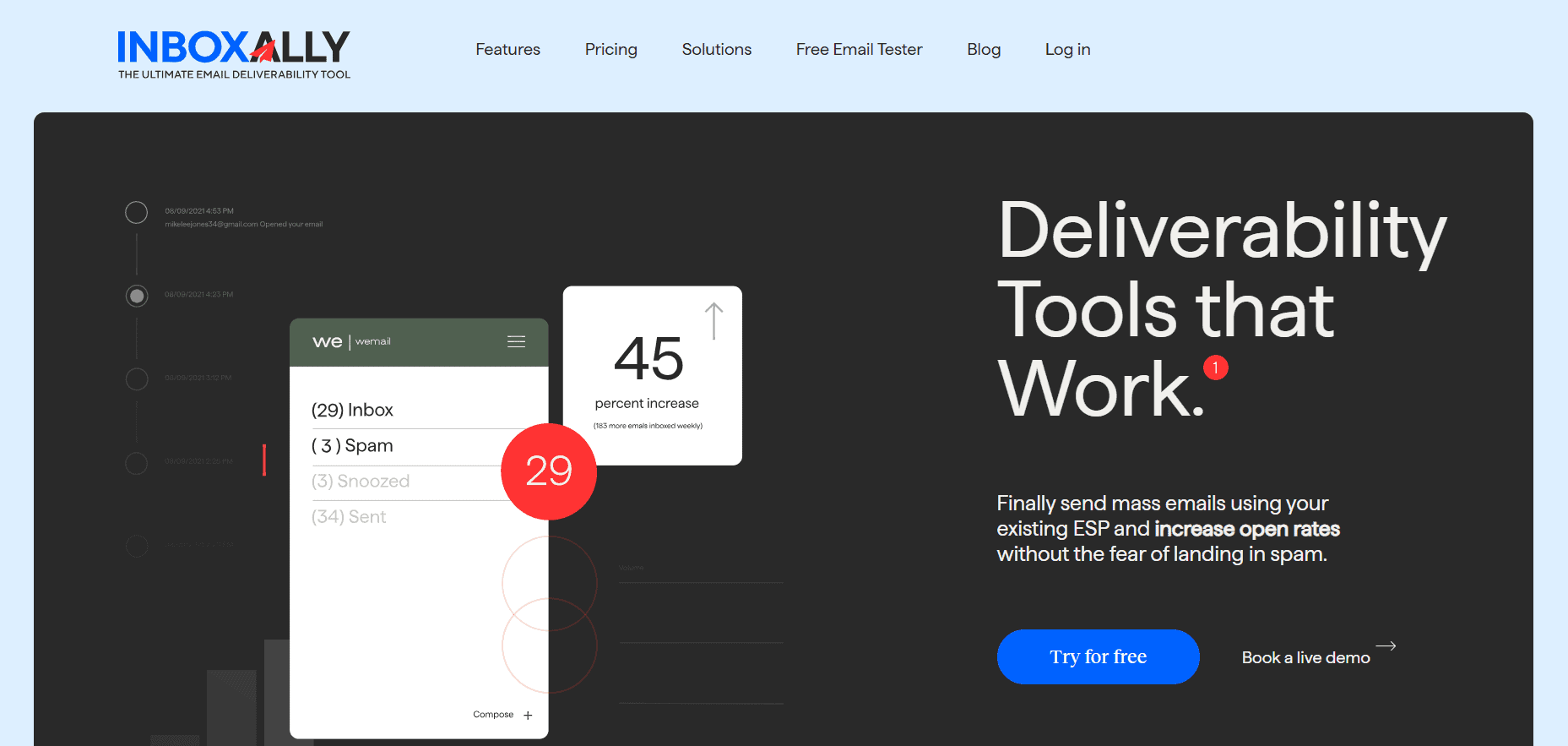Last Updated on November 28, 2025 by Ewen Finser
Email warmup is easily overlooked. It’s something that I didn’t even think about when I was launching my own business because it just wasn’t on my radar.
But if you’re about to launch a campaign, you can find yourself with poor results, with emails landing in spam folders and not being opened (speaking from experience). Email warmup improves deliverability and helps to avoid blocklists and other obstacles.
It turns out there are a ton of platforms designed to help with the warmup process. But when it comes to deliverability and overall usefulness, which one works the best?
I tested two platforms: InboxAlly and GlockApps. While they’re quite different, it was an interesting comparison. I’ll break down:
- The learning curve and UI/UX for each
- What features they both offer, and how these features help improve deliverability
- My opinion on which one is best
InboxAlly vs GlockApps – Key Differences
- InboxAlly offers email warmup features and reputation repair, whereas GlockApp focuses more on email and domain monitoring for improved deliverability
- InboxAlly’s UI is very smooth and easy to use, whereas GlockAlly’s UI is a little more cluttered and less easy on the eye
- InboxAlly has a lower learning curve and feels very easy to use, whereas GlockAlly’s learning curve is more difficult and will take more time to learn
- InboxAlly’s pricing is steeper, with a starting price of $149 per month, whereas GlockAlly offers a (limited) free plan with some useful monitoring features you can check out first
The Bottom Line:
InboxAlly and GlockApps are actually quite different, which makes comparison easier in some ways.
You could actually use them both for different needs at different times.
But from my perspective:
InboxAlly’s warmup tools are excellent. If you need to warm up your emails or you have a bit of a reputation damage situation to resolve, InboxAlly will take care of it. GlockApps, however, will help monitor your ongoing domain and email reputation.
If you’re starting out cold and you want to launch a new campaign, you will need InboxAlly’s features to make sure your emails land in the correct place. It works incredibly well and it’s just so easy for those who don’t have much time (like me).
But if you just want to maintain the status quo and make sure all is well, you might want to check out GlockApps, or at least give the free plan a try.
InboxAlly is the comprehensive suite I need to solve challenging deliverability problems across the board. It's like a triage hub for diagnosing and fixing email deliverability rates in one dashboard. I've tried a lot of tools, but this is the one I've stuck with.
InboxAlly vs GlockApps: Head-to-Head Comparison
A little trickier to learn | ||
Purpose | To warm up before email campaigns and to improve/repair email reputation | Domain monitoring and improved email deliverability |
Best For | Those wanting to keep things as simple as possible | Those wanting to monitor their domain and email performance |
Pricing | From $149 p/m | From $0 p/m |
Learning Curve | Easy | A little more tricky to learn |
Biggest Value | Customizable email warmup tools to suit your needs | In-depth monitoring to keep an eye on the running of your business |
When to Use InboxAlly
The first thing I want to mention is the UI. InboxAlly feels really smooth and easy to use, and not at all daunting. The learning curve is pretty decent, once you get your head around what your goals are.
For me, this is really important. I don’t have time to spend learning a complicated platform so this gives InboxAlly a huge advantage. I just want to log onto something, input some basic information, and let it do the work for me.
Basically, what I want from a platform like this is to take care of the tedious stuff so I don’t have to do it. I want it to do things like scrolling down through whole emails, removing them from promotions, marking emails as important and getting them out of those spam folders, etc.
Having that taken care of means that I don’t need to worry about doing any of it myself. But what makes InboxAlly extra helpful is that you can choose custom rules.
For example, you can choose ‘reputation boost’ or ‘reputation protect’, which will help your emails to stop landing in spam. Or you can go for ‘domain and IP reputation repair’ if you’ve attempted to launch your email campaign without warm-up, and now you need to repair the damage.
I also like ‘ramp up’, which is really useful before you launch a new campaign. Whatever you choose, it will warm up your inbox based on that. I like that there is a little bit of customization here to play around with, but not too much that it feels daunting. Plus,
But what I really like about it is that you can set rules like ‘reputation boost’ if you find your emails landing in spam, or ‘ramp up’ if you’re about to launch a promotion. I like that I can use it for specific things, and it will adjust its processes depending on that. It just gives me less to think about, while still offering customization to a certain extent.
Plus, it’s all done in a natural way that feels like human interaction, so you can just set it up and let it go without thinking about it again, and by the time your campaigns are ready, your deliverability will be so much better.

The analytics are good. You can quickly check metrics like open rates, which inbox the emails have landed in, etc. So you should be able to see right away if the warmup is working properly.
I also like that you can see who is clicking on/opening your emails, so you can see it working in real time, and you can see sender profiles and emails too.
At this stage, I need to talk about the pricing. InboxAlly does come with a cost. The lowest price of InboxAlly is $149 per month for 1 sender profile, email support, and 100 seed emails per day. The higher you go in price tiers, the quicker you can get the warmup done.
While I think the price is worth it because it’s just so easy, it’s definitely something to consider if you’re on a tighter budget.
The Bottom Line on InboxAlly
InboxAlly is great to use. It’s easy, it allows you some customization without being too complicated, and it’s simple to see the impact the platform is having. The downside is the price, but I think it’s worth it.
Read our Full InboxAlly Review here: My 2025 InboxAlly Review: Does this help with email deliverability?
When to Use GlockApps

I did find that GlockApp’s UI is a little less easy on the eyes than InboxAlly’s. It feels a little more overwhelming to navigate. Generally, you can find your way around okay, but it’s not that easy on the eyes.
The learning curve is a bit higher, which is something to consider. GlockApp offers some interesting features, but you’ll need to invest more time in learning how to use them properly. You may find that the features are worth it, though.
And this is where GlockApps stands out from InboxAlly. Rather than offering warmup tools, it offers monitoring and tracking so you can analyze what’s working and what isn’t. It’s designed to improve deliverability by highlighting what’s actually going on with your emails and domains.
It has features like automatic testing (so it will test mailboxes and report back without you having to do it), reputation monitoring including domain and IP analytics, monitoring against over 50 industry blocklists, and so on.
It measures your Spam Score by Google, Barracuda, and SpamAssassin. And the reports it delivers are very useful.

GlockApp will allow you to test metrics like sender score, blocklist records, inbox and spam folder placements, etc. This extends to your website, too. So if you want monitoring for timeouts, for example, you can take advantage of that. Domain health is a whole other ballgame, so it’s nice having that on the same platform.
They also offer premium services, which align a little closer to InboxAlly’s, which are priced separately. Like personalized strategies for your specific needs, and metric improvement on clicks and opens (so more similar to InboxAlly’s warmup strategies).
But I’d be wary of this, as some users report that it’s heavy on the upselling and not quite what they were expecting. And the pricing is unclear before you dive in and ask. So I would definitely do more research before committing to anything.
In terms of pricing, there’s a free plan on GlockApps, and this includes spam testing and uptime monitoring. The next price tier is $59 a month, which unlocks a whole bunch of DMARC analytics and more extensive uptime monitoring.
The Bottom Line on GlockApps
Really, GlockApps can be used in conjunction with InboxAlly. You could, in theory, use InboxAlly for the warmup and GlockApps for the ongoing monitoring, and that would work pretty well.
It has some great features, but the UI is a bit cluttered, and the learning curve is higher. But, having said that, there’s a free plan, and you can take advantage of some good tools without paying anything at all.
InboxAlly vs GlockApps: Which is Best for Improving Email Deliverability? – My Final Verdict
As always, it comes down to your needs. What I need might be completely different to what you need.
But if I were to sum it up, InboxAlly is better in a lot of ways. The UI is better, the learning curve is simple. And I think the features are great.
I like that you can customize InboxAlly depending on your needs. Reputation repair will require a slightly different process than campaign warmup, for example. So you can pick and choose, and I like that.
But I do think that GlockApps is good for ongoing monitoring. It has a bigger learning curve, and I’m not a fan of the UI. But if you want to monitor email and domain health, it’s solid. And the free plan is good to play around with, despite being quite limited.
You could use them both: InboxAlly to begin with, then GlockApps when you’re established. But for me, my favourite is InboxAlly. It’s focused specifically on email, and it works well for what I want it to do.
If you want to find out more about email warmup and how it works, you can check out our guide to the Best Email Warmup Tools.



